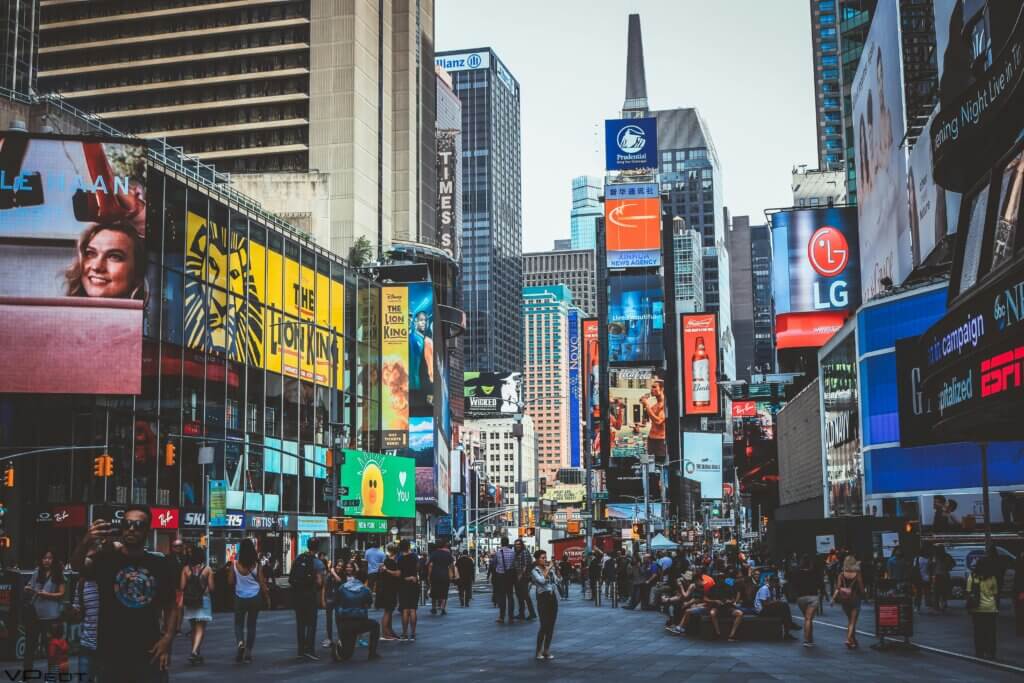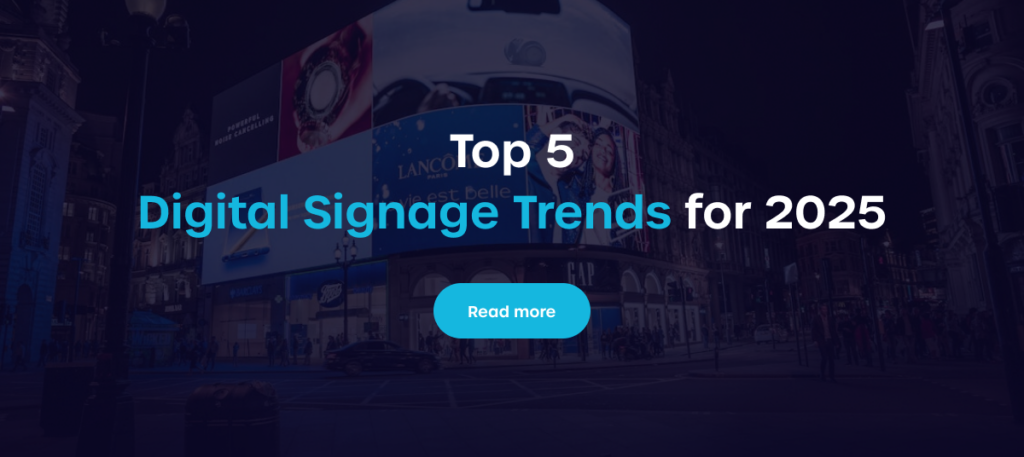3D billboards are redefining the way we experience advertising, captivating audiences with stunning visuals that leap off the screen. Unlike traditional flat displays, these innovative displays use cutting-edge technology to create the illusion of depth, transforming digital signage solutions into a dynamic, eye-catching medium.
The combination of advanced LED displays, precise viewing angles, and clever content design tricks the eye into seeing three-dimensional images without the need for special glasses. This technology is not just about visual appeal – it’s a powerful tool for brands looking to stand out in competitive markets. Today we dive into the mechanics behind these displays and explore their growing impact in the digital signage trends.
The Rise of 3D Digital Billboards

In recent years, 3D digital billboards have revolutionized the landscape of outdoor advertising, capturing the attention of consumers in ways that traditional flat signage simply cannot. As cities become increasingly competitive with advertising space, the demand for 3D billboards continues to surge, pushing the boundaries of creativity and technology in the world of marketing.
What are 3D Billboards?
3D billboards are a form of outdoor advertising that uses digital technology to create captivating, lifelike images that appear to pop out from the screen. Utilizing advanced display techniques, these billboards can showcase animations and graphics that provide an immersive experience for viewers, enhancing the overall effectiveness of the advertisement. By leveraging the power of visual storytelling, digital 3D displays allow brands to convey their messages in a more impactful manner.
Why are 3D Billboards so Popular?
The popularity of 3D screens in digital signage trends can be attributed to their ability to grab attention and evoke curiosity. In an era where consumers are bombarded with advertisements, the unique visual effects offered by 3D advertising billboard stand out significantly. Furthermore, these displays can be updated in real-time, enabling advertisers to tailor their messages based on specific events, trends, or audience demographics.
How 3D Billboards Work?
The magic behind 3D billboards lies in the intricate technology that powers them, making it essential for advertisers to understand how these displays function. Unlike standard flat billboards, digital 3D displays use optical illusions, high-resolution displays, and advanced LED technologies to create realistic depth effects. This level of sophistication not only enhances the visibility of the advertisement but also enriches the viewer's experience as they interact with the content on a subconscious level.
The Technology Behind the Magic
At the core of 3D digital billboards is a combination of high-definition screens and specialized software that helps produce 3D images. These billboards often utilize holographic technology or stereoscopic projection to achieve the illusion of depth, transforming static advertisements into lively, animated experiences.
A standard 3D billboard without movable parts uses anamorphosis, a technique where the image is cleverly distorted during its creation. This approach allows viewers to perceive depth where none exists. It is also crucial to install such a display in the right location, as it creates the perfect 3D impression only when viewed from the correct angle. Example of a screen created in this technique could be Nike Air Max Billboard located outside Shinjuku Station in Tokyo, Japan.
There are also 3D billboards that use movable parts. For instance, the Coca-Cola billboard in Times Square, New York, measures approximately 68 by 42 feet and contains 1,760 LED cubes, each of which can move independently to create amazing experiences for viewers.
Design Process for 3D Billboards
The design process for 3D advertising billboard is crucial, emphasizing creativity and technical know-how. Designers must consider various elements, most importantly:
- Lighting: Optimize illumination for realistic 3D effects by carefully balancing brightness, contrast, and shadow to enhance depth perception. Proper lighting ensures the 3D visuals remain vibrant and engaging, even in varying environmental conditions, such as day or night.
- Perspective: Align visuals for a seamless viewer angle by taking into account the intended audience’s viewing distance and position. Using techniques like anamorphic distortion, designers can ensure the 3D effect appears perfect from key vantage points, creating an immersive experience.
- Motion: Add dynamic movement to captivate audiences and make the content more visually appealing. Animations or independently moving elements can grab attention and create a sense of interaction, keeping viewers engaged longer and increasing the billboard's impact.
Software Powering 3D Billboards
To manage the complexity of 3D billboard content, specialized digital signage software is required. These tools play a significant role in ensuring that the displays function seamlessly, allowing advertisers to easily schedule ads, create new content, monitor performance, and make real-time adjustments as needed.
Combination of advanced tools
To display content on unique screens like 3D billboards, a specialized combination of software tools is essential. Typically, 3D modeling software is used to create the 3D rendering of the billboard, utilizing techniques like anamorphosis to produce breathtaking images. Digital signage software then plays a crucial role in displaying this 3D rendering on the billboard in real-time, ensuring an effective presentation to viewers. This combination allows for dynamic and visually impactful advertising and communication on such advanced displays.

Some projects also require adjustments, depending on the complexity of the billboard. For example, Coca-Cola billboard requires its own technology to choreograph the velocity, acceleration and position of the individual modules. The developers created custom software that allows for this 3D simulation and enables the brand to easily preview, modify and export content for playback on the sign.
The system operates with just two content files: one containing the visual and the other defining the position of each module. After the content is uploaded, the software sends instructions to the individual modules and applies a motion algorithm to achieve smooth movement and an optimal visual design. Because of that design, the software is user friendly. Extensive development or programming knowledge is not required to upload new content.
Managing 3D Billboard Displays
Managing 3D billboard displays involves tracking their performance and ensuring that the content is engaging and relevant. Digital signage solutions now come equipped with advanced analytics tools that allow advertisers to evaluate the effectiveness of their campaigns and make data-driven decisions. This strategic approach not only maximizes return on investment but also enhances the overall viewer experience by delivering personalized advertisements based on audience engagement.
Strategy for 3D advertising billboard is not any different from flat displays. Therefore, you have to:
- Monitor and optimize display performance regularly.
- Utilize advanced analytics to assess campaign success.
- Leverage data insights for strategic decision-making.
- Focus on maximizing ROI through targeted content.
- Enhance viewer engagement with personalized ads.
Tools for 3D Content Creation
The creation of captivating content for 3D billboards demands the use of sophisticated design tools. Incorporating 3D modeling and animation software, advertisers can craft visually stunning graphics that draw in audiences and communicate their message effectively. It is this harmonious blend of technology and creativity that sets 3D billboards apart from traditional advertising mediums.
These tools often include industry-standard software like Blender, Maya, or Cinema 4D, which provide robust features for designing, animating, and rendering complex 3D visuals. Advanced texturing techniques, lighting simulations, and real-time rendering capabilities ensure that the content looks realistic. These features help it align seamlessly with the billboard’s motion or static display capabilities. Additionally, specialized plugins and post-production tools can fine-tune animations to ensure smooth transitions and flawless performance on large-scale displays.

The Future of 3D Billboard Advertising
Looking ahead, the future of 3D billboard advertising is filled with exciting possibilities as technology continues to advance. As those immersive outdoor displays become more commonplace, their integration with augmented reality and other digital platforms will expand their reach and accessibility, ultimately redefining how brands connect with consumers.
Innovations in 3D Technology
The rapid evolution in 3D technology is paving the way for interactive experiences that could transform the advertising landscape. For instance, integration with mobile apps and AR experiences can allow viewers to interact with 3D billboards in real time, fostering deeper connections between brands and consumers.
Another example is the use of AI-driven content adaptation. 3D advertising billboard can analyze real-time data, such as weather, time of day, or audience demographics, to dynamically adjust visuals and messaging, creating highly personalized and contextually relevant advertisements that capture attention effectively.
Expanding Accessibility
As the technology behind 3D billboards becomes more advanced and cost-effective, it is anticipated that their accessibility will expand to smaller businesses and emerging brands. This democratization of technology allows a wider range of advertisers to craft compelling campaigns that leverage the power of 3D displays. In turn, this trend can lead to an enriched advertising ecosystem where creativity and innovation thrive across various industries.
FAQ
What are 3D billboards, and how do they create the illusion of depth?
3D billboards are advanced advertising displays that utilize digital technology to produce stunning, lifelike imagery that appears to jump off the screen. By employing techniques such as stereoscopic projection and holography, these billboards create captivating visual experiences that engage viewers more effectively than traditional flat displays. This illusion of depth is a key component of why 3D advertising screens have gained immense popularity.
Which software is commonly used for creating 3D billboard content?
The creation of content for 3D billboard often involves using specialized software such as Autodesk Maya, Blender, and Adobe After Effects. These tools allow designers to produce high-quality 3D animations and graphics tailored for various advertising contexts. By leveraging these software solutions, creatives can ensure that their 3D advertising billboard delivers the intended message with maximum impact.
How is 3D billboard technology expected to evolve?
The future of 3D billboard technology holds exciting promise as it continues to evolve with advancements in digital displays, interactive technology, and augmented reality. We can expect more immersive experiences that allow viewers to engage with advertisements in real-time. As the industry adapts to these innovations, 3D digital screens will likely become a vital component of marketing strategies.







